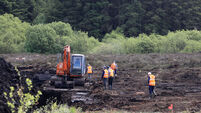Moloney proud to hold the line for the county
The impression could be that this is a man with his back to the prevailing wind blowing from the southwest, but in fact he is like a ship's captain caught between gales one pressing relentlessly from the direction of the city, the other hitting County Hall in high-pressure bursts of developmental lobbying.
"The fact is that we get a fantastic view in all directions from up here," says this softly-spoken manager.
"It allows us a clear sense of vision."
Geographically speaking he's right and geography is the force behind that gale blowing from the city. This is the question of an extension to the city boundary, last moved outwards in 1965 with a disastrous if temporary effect on relations between both local authorities. Joint committees formed in 1973 alleviated the tension; more recently the development of the Cork Area Strategic Plan covering what is being called "Metropolitan Cork" (the city centre, suburbs, satellite towns from Bandon to Fermoy, identified industrial areas and villages) for a 20-year programme is a huge mutual enterprise.
"We have been informed recently by City Hall that it intends to apply for a boundary extension and we have agreed to give them the information they need to do that. But given the level of co-operation that exists why is an extension necessary? There has been no answer to that question as yet. Boundary extensions are very divisive; this is more than just a line on a map and should only be contemplated if a clear statement is given as to what the claimant authority would do that the other authority isn't doing. After all we have a common policy as to the land uses in the city and surrounding area, and agreed zoning policies with which both authorities are expected to comply. So is the intention of a boundary extension to depart from those agreed strategies?
Do we just want to roll out the city and build and build? Broadly supported at government level, CASP is a matter of vision, an attempt to make sure that outlying districts don't just become signposts but remain identifiable places with an image of their own. What would a boundary extension do to that?"
Convinced that it would be "unthinkable" to have a city that stretched from Ovens to the harbour, Moloney uses and re-uses the word "vision" as the key both to the maintenance and the strategic planning of Ireland's largest county, its environment and services. And he believes that the elected representatives who serve as councillors have an honourable record in sharing and upholding that vision even where it can threaten local concerns. They have just overseen the completion of the new County Development Plan (a snip at 95 from today or, with display maps, at 145) which plots the county's agenda for the next six years.
"The whole process of public consultation produced about 3,500 submissions 75% of them from landowners, large or small. The critical issues concentrated on about 15 serious proposals for land zonings which we considered would not be in line with the CASP policy. I'm proud of the fact that in virtually every one of these cases the CASP strategy remained intact, despite intensive lobbying which only became visible as councillors were going crucial meetings but which had been going on behind the scenes long before. All that was resisted in favour of a strategy that sets a course for the county for 20 years, not just the six included in the plan. I think that's admirable."
The strategy sees development in the county concentrated along existing and re-opened rail lines, especially to the north and east from Blarney to Midleton. The investment of 130 million is required, which includes the cost of rolling stock, seems so modest to Moloney as to be a justification in itself.
"We're trying to get the timing of the population movement and the rail-line to coincide: Luas is a matter of the line following the people. Here we hope at least to ensure that the quality of life for people in and around the city will not diminish; we have to ensure that the unstoppable nature of what's happening in Dublin shouldn't define Cork."
It is, in other words, a matter of holding the line. As at the proposed town of Annaghmore between Cork and Bandon, finally refused by the council because it was significantly car-dependent and therefore contrary to the railway-based plans. Moloney accepts that the developers are entitled to make their case, but feels that there is little public recognition of the work the council officers do to explain and defend the integrity and coherence of the planning strategy against what he calls "a dangerous coalition" of owners, developers and builders trying to make the councillors change the published criteria.
Issues of density, one-off housing, and high-profile property sales such as Dunkettle House (where zoning criteria will determine the impact of development) are all to be settled within the context of that strategy. In their defence of it the county councillors, according to Moloney, have shown the quality of their commitment to their vision for the county.













